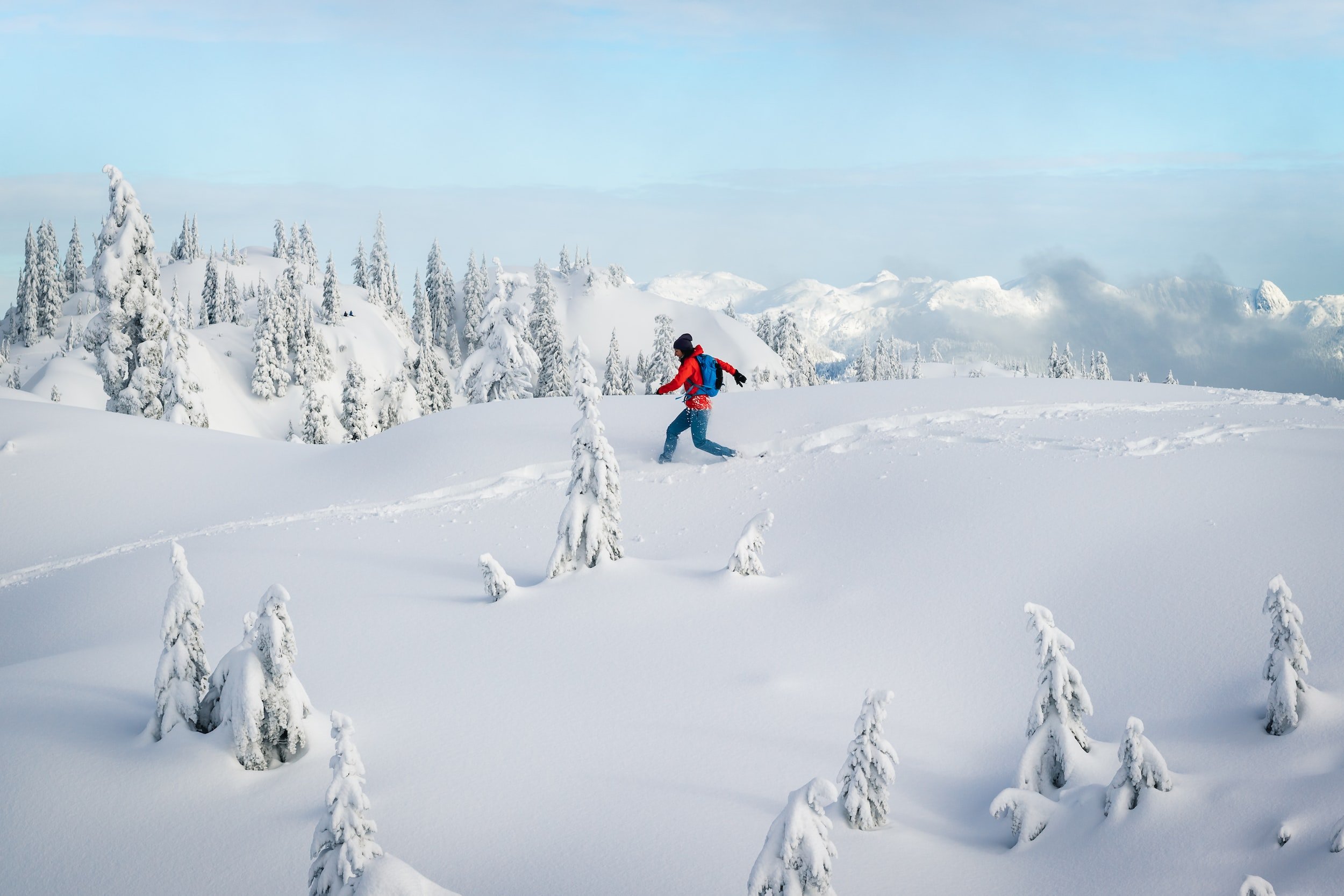The Complete Guide for Snowshoeing Beginners
Snowshoeing in the Moutains
It might surprise you to learn that snowshoes have been used by humans for winter travel for nearly 6,000 years! Here in the Canadian Rockies, many winter enthusiasts use the snowshoe as an accessible way to explore our winter wonderland.If you’re curious to try out this ancient method of transportation, here’s our guide for snowshoeing beginners so you can get started.
1.Dress For Cold Weather
Nobody wants frozen toes and fingers! Temperatures can fluctuate wildly in the Rockies, with the early morning lows and midday highs sometimes seeing a 20- or 30-degree difference.
In Canmore, our coldest weather usually occurs from late December to early January, with frigid arctic winds bringing the temperature down to -40C/F. In February and March, you’ll find lows typically around -15C/5F, and spring will often rise above freezing.
Before you layer up, consider the time of day you’ll be setting out for your adventure. Early morning starts might be appealing for skiers looking for first tracks, but often a snowshoe trail will have fresh powder all day, so there’s no rush to get out there on chillier days.
Snowshoeing beginners often want to bundle up, but you’ll want practical layers that can be added or removed. Shed a layer before that uphill push, and then put an extra layer or two back on when you stop for a rest to admire the view. Your layering should always include a moisture wicking base layer like merino wool, a thermal layer like synthetic or down and a windproof and waterproof outer shell like Gore-tex. From there you can add any additional layers that you might need depending on the conditions.
2. Plan Your Gear
There are plenty of features to consider before you rush out to buy your first set of snowshoes. Most modern snowshoes consist of plastic decking stretched across a metal frame, with a foot binding and crampons situated near the front of the shoe. You’ll find popular brands like Atlas, Tubbs, MSR, McKinley and more at your local outdoor equipment shop.When selecting your snowshoe, look for features like:
● Crampons – These are the metal teeth that are on the underside of the snowshoe. They’re designed to dig into hard snow or ice, to provide extra grip when going up or down hill. Crampons are included on most modern snowshoes, but it’s always good to check as some cheaper models might not have this feature.
● Heel Raiser – This is a small metal bar that can be propped up underneath your foot, creating a platform for you to step on as you’re ascending. If you’re planning on tackling some elevation on your snowshoe trips, you can save your calves a gruelling workout by opting for shoes that include a heel raiser.
● Size and Shape of the Snowshoe– As a general rule, the heavier you are, the larger snowshoe you’ll need to keep you above the snow. Consider if you’ll be heading off the beaten path and breaking trail, or if you’ll be sticking to packed, well-travelled routes. Use a size guide and don’t forget to add the weight of your pack when calculating!
After you have your snowshoes, you can easily take to the powder, but there are a couple more things that will make your outing a little easier. The best accessory for a snowshoeing beginner is hiking poles or ski poles, as they’ll help keep you upright when the snow shifts beneath you. You may also want gaiters to keep your feet dry. Choose ones that cover from calf to ankle so your day isn’t ruined by snow melting in your boots.
3.Choose The Right Trail
Choosing where to snowshoe in the Canadian Rockies can be a challenge—there are so many options that will lead you to an immersive winter wonderland!
Determining where to snowshoe depends on what your objectives are for the day. Decide if you’d like a casual hour-long stroll over flat terrain, or if you’d like to challenge yourself to some elevation with a mountainous climb.
Kananaskis Country is home to a plethora of snowshoe trails. You’ll be awestruck by the frozen lakes, mountain peaks and snow-blanketed forests—there’s so much to explore, even for snowshoeing beginners..
4.Get Out There on the Trails
It’s time to strap in and start breaking trail! It might take a little bit of practice, but within a few strides most people get the hang of walking in snowshoes.
Remember that being the first to pack down the snow on the trail can quickly become tiring. Try rotating your group as you go so everyone does their share of the work and gets to enjoy a flattened path, too.
During a summer hike it’s often easy to follow a designated route on a well-marked trail. When snowshoeing, you can make the route anywhere—but this comes with navigation challenges. If you’re not paying attention or the weather causes low-visibility, your tracks may get filled in. Make sure you have a map or GPS device, and if the conditions are bad, don’t venture too far from the road.
5. Hire An Experienced Guide
Snowshoeing for beginners should be an unforgettable experience, not stressful. You can alleviate any uncertainty by recruiting the expertise of a knowledgeable local guide. Relax and enjoy your vacation with a tailor-made experience, specifically designed for your group. Your guide will select the ideal location for your snowshoeing outing, in an area that will give you a sense of adventure and accomplishment, while prioritizing the safety and comfort of everyone.
Practice the skills of snowshoeing for beginners with provided equipment as your guide shares compelling stories of the history of the mountains, and fascinating details about the surrounding nature and geology. You’ll also love the hot beverages and delicious treats to keep you satiated throughout your trek.
Your Dream Getaway Is Here
Enjoy a luxury guided excursion your whole family will reminisce about for years to come. Customize your experience with a soak in the hot springs or a bite to eat at a local restaurant, all with door-to-door service and your own private guide. Snowshoeing tours are available from Canmore or Banff. Book now to plan your wonderful winter vacation.
Author: Andrew leighfield
Andrew is a professional IGA guide and works with Canadian Rockies Experience. He is passionate about sharing his knowledge of this place he calls home.








